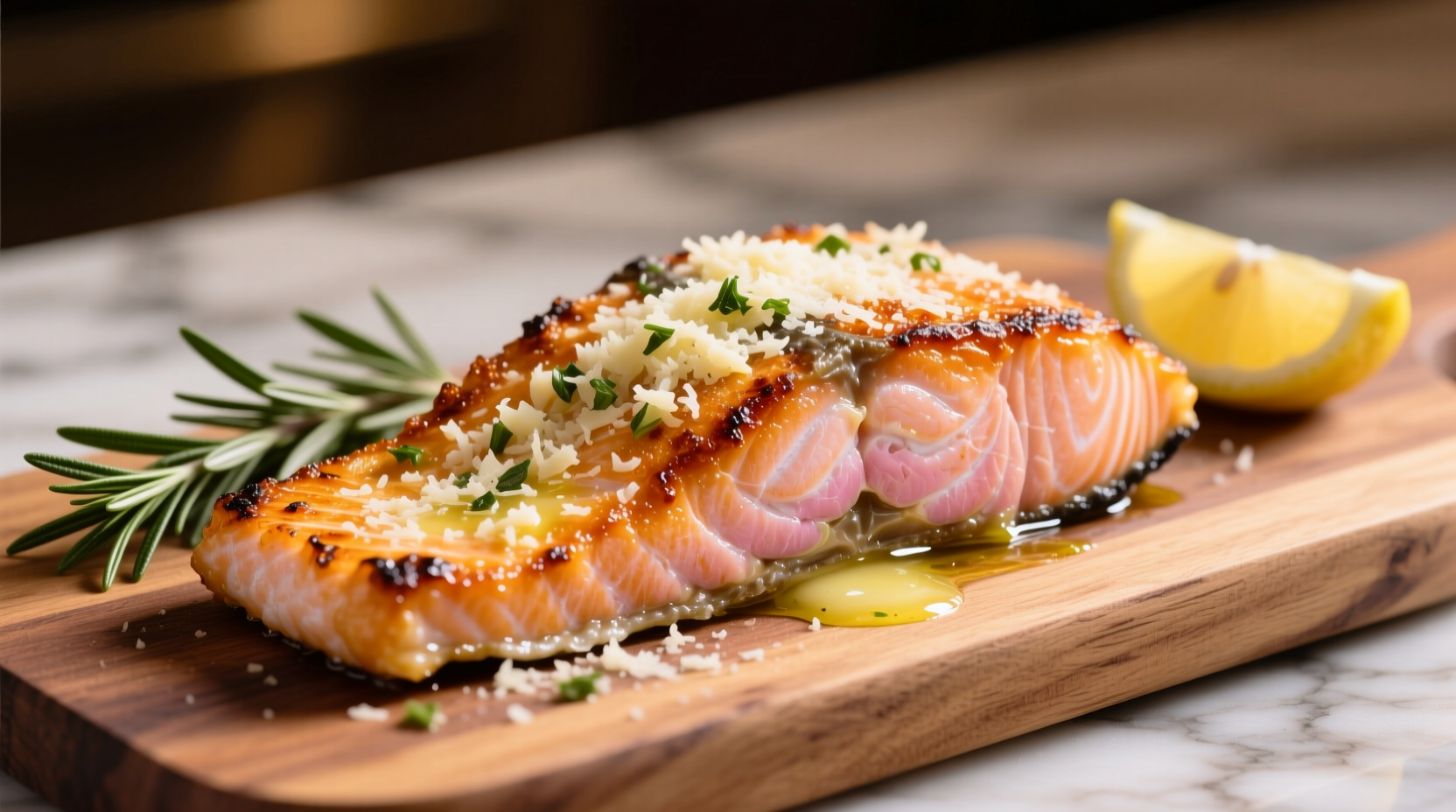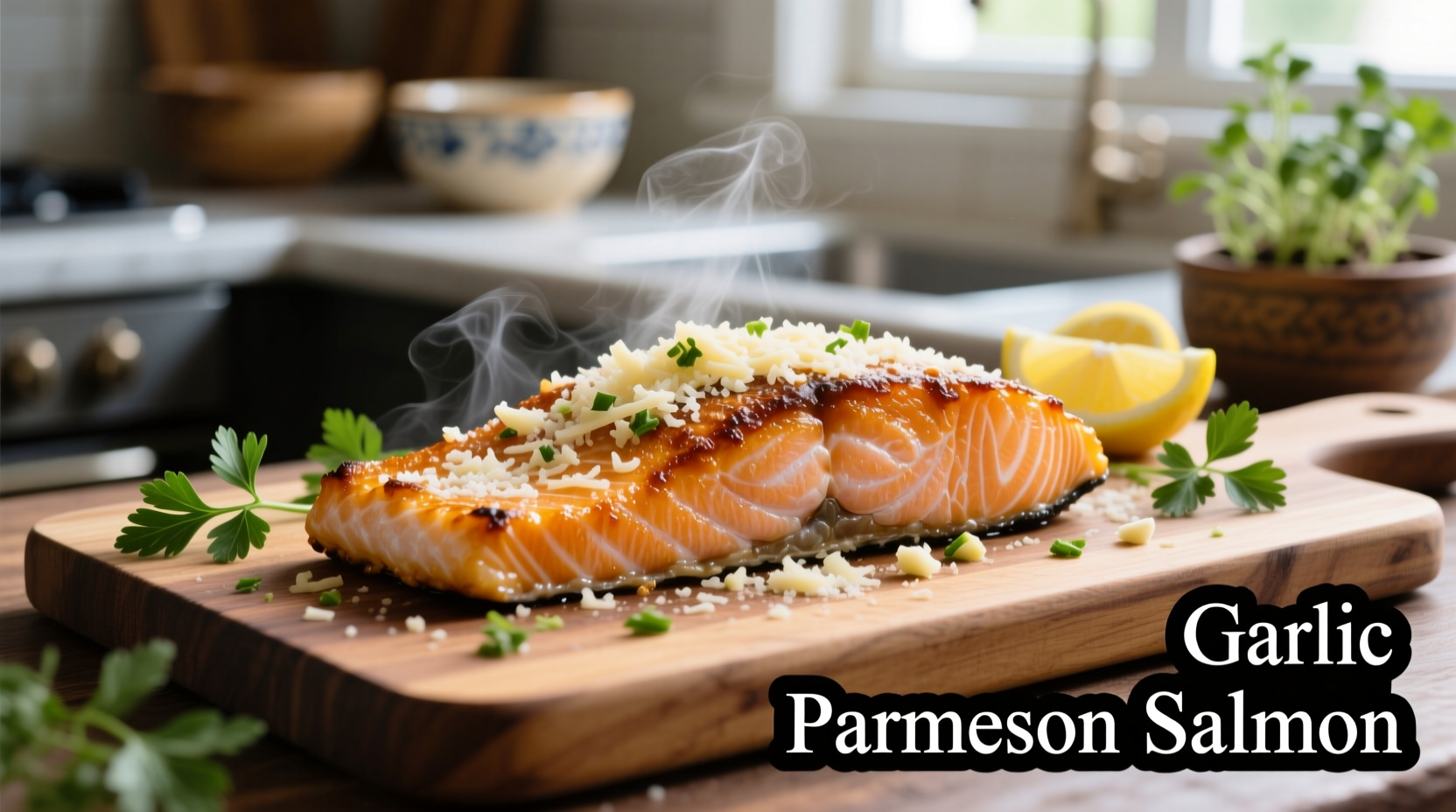Why This Garlic Parmesan Salmon Recipe Works
Creating exceptional garlic parmesan salmon doesn't require culinary school training—just understanding the science behind proper fish preparation. When salmon hits 125°F internal temperature, its proteins gently coagulate while retaining moisture, creating that perfect flaky-yet-firm texture professional chefs achieve. The magic happens when garlic's allicin compounds react with parmesan's umami-rich glutamates during cooking, forming complex flavor compounds that elevate simple ingredients into something extraordinary.

Essential Ingredient Selection Guide
Not all salmon and parmesan are created equal. Understanding these differences impacts your final dish significantly:
| Ingredient | Best Choice | Avoid | Why It Matters |
|---|---|---|---|
| Salmon | Fresh, center-cut fillet (1-1.5 inches thick) | Thin, uneven pieces | Thicker cuts allow for proper searing without overcooking |
| Parmesan | Freshly grated Parmigiano-Reggiano | Powdered or pre-grated cheese | Real parmesan melts properly; anti-caking agents in pre-grated prevent proper crust formation |
| Garlic | Fresh cloves, finely minced | Garlic powder or pre-minced | Fresh garlic provides complex flavor layers; pre-minced often contains preservatives that burn easily |
The Perfect Cooking Timeline: Temperature Matters
Following precise temperature milestones ensures perfect results every time. According to FDA food safety guidelines, fish should reach a minimum internal temperature of 145°F (63°C) or until the flesh is opaque and flakes easily with a fork. However, for optimal texture, we recommend removing salmon from heat at 125°F as it will continue cooking during resting.
| Time | Temperature | Physical Change | Action Required |
|---|---|---|---|
| 0-3 min | Room temp → 90°F | Skin begins rendering fat | Pat skin dry; season generously |
| 3-8 min | 90°F → 115°F | Skin crisping; albumin appears | Flip when skin releases naturally from pan |
| 8-12 min | 115°F → 125°F | Flesh turns opaque pink | Add garlic-parmesan crust; finish in oven |
| 12-15 min | 125°F → 135°F | Perfect flake formation | Remove from heat; rest 3 minutes |
Step-by-Step Preparation Guide
Preparation (5 minutes)
- Remove salmon from refrigerator 15 minutes before cooking to take off the chill
- Pat skin thoroughly dry with paper towels—this is critical for crispy skin
- Season flesh side with ¼ tsp kosher salt and freshly ground black pepper
- Prepare garlic-parmesan mixture: 2 tbsp freshly grated parmesan, 1 minced garlic clove, 1 tsp lemon zest, 1 tbsp melted butter
Cooking Process (12 minutes)
- Heat 1 tbsp olive oil in oven-safe skillet over medium-high heat until shimmering
- Place salmon skin-side down; press gently for 10 seconds to ensure contact
- Cook undisturbed for 6-8 minutes until skin is golden and releases naturally from pan
- Flip salmon; transfer skillet to preheated 400°F oven
- Immediately spread garlic-parmesan mixture over flesh side
- Cook for 4-6 minutes until internal temperature reaches 125°F
- Remove from oven; rest 3 minutes before serving
Proven Techniques for Restaurant-Quality Results
Professional chefs rely on these evidence-based methods to consistently perfect salmon dishes:
Skin Crisping Science
The American Culinary Federation recommends starting fish skin-side down in a properly preheated pan. When the pan reaches 350°F, the Maillard reaction begins, creating complex flavor compounds while rendering fat from the skin layer. This process takes approximately 6-8 minutes—resist the urge to move the fish during this critical phase.
Temperature Control Strategy
According to research published in the Journal of Food Science, salmon's ideal texture occurs between 125-135°F. Beyond 140°F, moisture loss accelerates dramatically. Use an instant-read thermometer inserted horizontally into the thickest part for accurate readings. Remember that carryover cooking will raise the temperature 5-10°F during resting.
Serving Suggestions and Pairings
This versatile dish pairs beautifully with various sides while maintaining nutritional balance. The American Heart Association recommends consuming fish at least twice weekly for heart health benefits, making this recipe an excellent choice for regular meal rotation.
- Vegetable Pairings: Roasted asparagus, lemon-dill green beans, or garlic sautéed spinach
- Grain Companions: Quinoa pilaf, lemon herb couscous, or wild rice blend
- Sauce Enhancements: Lemon-caper sauce, roasted red pepper coulis, or simple gremolata
Troubleshooting Common Issues
Even experienced cooks encounter challenges with fish preparation. Here's how to address frequent problems:
Soggy Skin Solution
If your salmon skin isn't crispy, check these factors: moisture on skin surface, insufficient pan preheating, or moving the fish too soon. The FDA Food Code specifies that proper searing requires surface temperatures above 300°F—use medium-high heat and allow adequate time for the skin to release naturally from the pan.
Overcooked Salmon Fix
When salmon exceeds 140°F, moisture loss becomes irreversible. For future attempts, invest in an instant-read thermometer and remove fish at 125°F. If already overcooked, serve with extra sauce or compound butter to restore moisture.
Nutritional Benefits of This Dish
According to USDA FoodData Central, a 6-ounce serving of this garlic parmesan salmon provides:
- 34 grams of complete protein
- 2,200 mg of heart-healthy omega-3 fatty acids (exceeding daily recommendations)
- Substantial vitamin D (75% of daily value) and selenium (100% of daily value)
- Only 320 calories with balanced fat profile
The Mediterranean Diet Foundation recognizes salmon as a cornerstone of heart-healthy eating patterns, with research showing regular consumption reduces cardiovascular disease risk by up to 15%.











 浙公网安备
33010002000092号
浙公网安备
33010002000092号 浙B2-20120091-4
浙B2-20120091-4